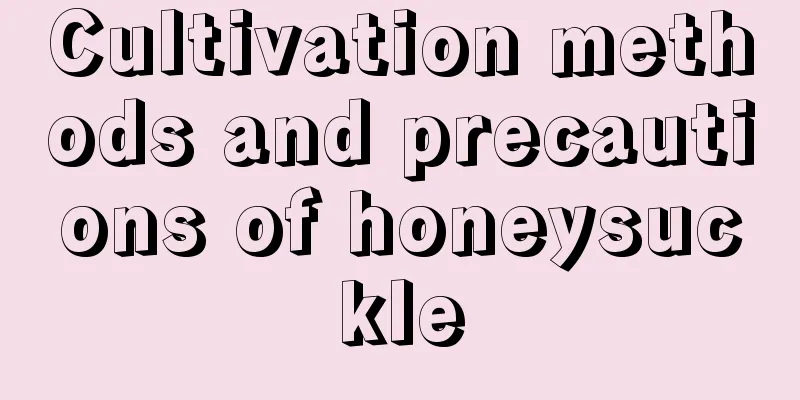Cultivation methods and precautions of honeysuckle

|
Honeysuckle is what we often call honeysuckle. The flower is white when it first blooms, and then slowly turns yellow. It can also climb and form a large patch. It is a vine plant . Below, the editor will introduce the cultivation methods and precautions of honeysuckle, let’s take a look. 1. Soil Use fertile soil with good drainage to cultivate honeysuckle. It likes to grow in a loose and breathable environment. Too sticky soil will prevent it from taking root normally. 2. Lighting Give honeysuckle at least 5 hours of light every day. Remember to rotate the pot after being exposed to the sun for a period of time so that the plant receives light evenly. Insufficient light will cause it to droop and appear in poor condition. 3. Ventilation The most important point when planting honeysuckle potted plants is to place them in a well-ventilated and air-permeable place. It is best not to place them too deep in the house or in a corner, and do not place them together with other potted plants. They must be placed in a well-ventilated place like a windowsill. 4. Watering Water the honeysuckle once every 2-3 days. If you use tap water, let it sit for a while before watering the plant. Increase the frequency of watering appropriately in summer and reduce the amount of watering in winter. Be careful not to over-water and just keep the soil moist. Don't overwater it during flowering period. 5. Fertilization Honeysuckle is generally fertilized in spring and autumn, which is its growing season. Apply more fertilizer to it. You can apply compound fertilizer , organic fertilizer , etc., but not too much at one time. You can also choose to apply organic fertilizer to it, twice a month. 6. Pests and diseases The main prevention and control measures are leaf spot disease and aphid infestation. The affected branches and leaves should be cut off in time, and appropriate drugs should be used for intervention. Be careful not to spray before or after flowering. 7. Notes Honeysuckle can be propagated by sowing, and the sowing time is generally chosen in March. The honeysuckle also needs to be pruned appropriately, usually in spring, and it is best to prune from the inside out. Also remember to drain the honeysuckle when there is plenty of rain. The above are the cultivation methods and precautions of honeysuckle. Honeysuckle's color will gradually change from white to yellow, hence its name. It is also called mandarin duck vine. It can be grown outdoors, on the ground or indoors and made into beautiful potted plants or bonsai, and it is very easy to grow.
|
Recommend
What kind of soil should be used to grow banyan trees? Can coconut brick soil be used?
1. What soil to use for cultivation The banyan tr...
Succulent varieties suitable for hydroponics
Commelinaceae Most of the succulents belonging to...
How to take care of the newly bought iris
1. Watering The newly bought irises can be plante...
How to propagate violet spider plant and what to pay attention to
How to propagate violet spider plant There are fo...
How to grow red palace water plants well
Growth conditions of red palace water grass The t...
How to care for Margaret chrysanthemum
Margarite Chrysanthemum Growing Conditions Margar...
What is cat's claw? What is its Chinese medicine name and medicinal value?
Cat's claw is a herb with great medicinal val...
Diseases of Prunus aviculare and their control
Diseases of Prunus aviculare and their control Di...
How to make the leaves of Bear's Paw take root? Can the leaves be planted?
1. How to make the leaves of Bear's Paw take ...
Diseases of cherry blossoms and their prevention and treatment
Cherry Blossom Leaf Blight Symptoms This disease ...
Balixiang cantaloupe planting and management
Balixiang cantaloupe, bred by experts from Beijin...
Wheat Growth Conditions and Characteristics
Wheat growing conditions Wheat is a long-day crop...
How to grow Aloe Queen
1. Maintenance methods 1. Temperature: It does no...
How to plant green vegetables and when to plant them What should be paid attention to during management
Suitable time for planting green vegetables Green...
How to propagate Daphne
1. Layering method 1. The layering method can be ...









